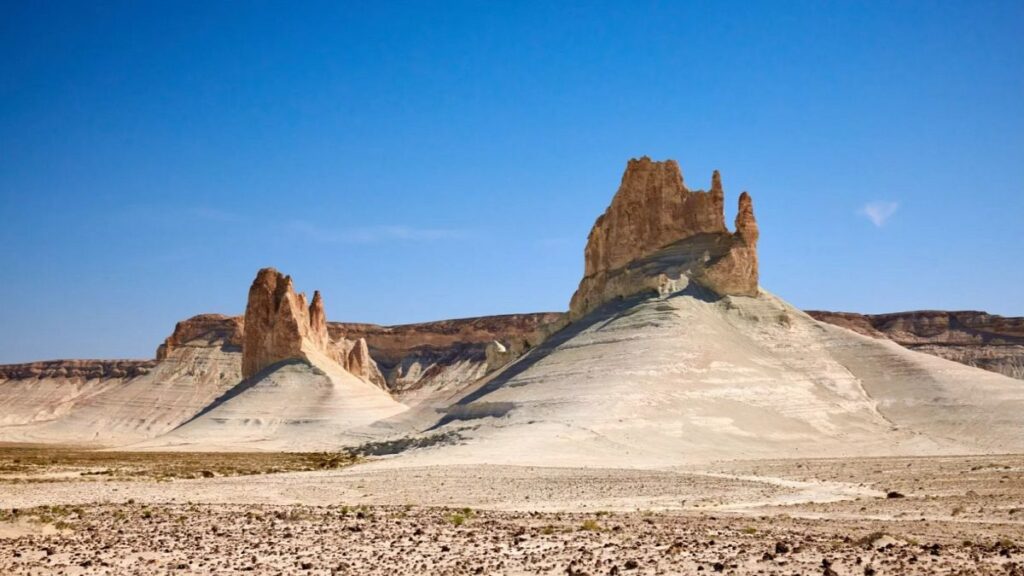By Tomiris Bilyal
Published on
Imagine seeing Martian terrain with your own eyes without ever leaving Earth.
Mangystau in southwest Kazakhstan stands out for its otherworldly landscapes and diverse geography.
Stretching from the Caspian Sea to desert plateaus, the region brings together natural landmarks and cultural heritage sites that are increasingly drawing the attention of travellers.
Martian landscapes on the seabed of an ancient ocean
Bozjyra Gorge is a must-visit in Mangystau, a place that has become a symbol of the region’s natural beauty.
Its iconic white cliffs are remnants of the Tethys Ocean, which covered this part of Kazakhstan 60-80 million years ago. The towering “teeth” of Bozjyra rise like alien monoliths 250 meters above the Ustyurt Platуроeau.
Even today, you can spot fossilised seashells scattered across the rock. It’s a reminder that this valley was once a vast seabed.
By this autumn, travellers will be able to take in Bozjyra’s dramatic landscapes from the new panoramic terrace of a visitor centre set to open in the coming months.
“A new visitor centre is now under construction in Bozjyra, complete with glamping yurts, a cultural museum, and a panoramic restaurant serving Kazakh cuisine,” said Yersin Ibrashev, Head of the Tourism Department of the Mangystau region.
Not far from Bozjyra, the striped hills of Kyzylkup, also known as Tiramisu Canyon, along with Mount Bokty, Tuzbair Salt Pan, the mysterious Torysh Valley of Balls, and the Senek Sand Dunes only deepen the impression that you’ve landed on a different planet.
Along Mangystau’s northern coastline lies one of the region’s most unusual landforms Zhygylgan, or ‘Fallen Earth’. It looks like the ground has cracked and collapsed, leaving behind broken cliffs.
Tours to Zhygylgan are often combined with visits to underground mosques along the route.
A land of pilgrimage with sacred mosques hidden in stone
Mangystau is home to some of the region’s most sacred sites – the underground mosques of Beket-Ata and Shopan-Ata.
Carved into the rock between the 12th and 18th centuries, these necropolises have become important pilgrimage destinations in Central Asia. In 2024, the region’s five cave mosques were added to UNESCO’s Tentative List.
Organised tours to these spiritual landmarks run regularly from Aktau, the region’s main city. Along the way, you might spot camels, wild kulans, desert foxes, or arkhar antelopes moving across the steppe.
Kazakhstan’s Caspian coast retreat
As the only region in Kazakhstan with a seacoast, Mangystau is also embracing its maritime potential.
Just south of Aktau, Kenderli Bay is being transformed into a modern seaside resort. With shallow waters and a 25-kilometre stretch of sandy beach, it’s ideal for swimming, sunbathing, and family getaways.
To support this transformation, a new international airport is under construction just 13 kilometres from the bay. The facility is expected to open in early 2026 with direct flights to the country’s major cities and beyond.
A seaside escape is also possible right in the city of Aktau. Here, a rocky trail runs for 1.5 kilometres along the cliffs, opening wide views of the Caspian Sea.
Aktau is also home to the first five-star, all-inclusive resort in Central Asia, located directly on the waterfront. It offers beach access, year-round service, and all the essentials for a comfortable stay.
How to reach Mangystau
While Mangystau feels remote, reaching it is becoming easier each year. The main entry point is Aktau with flights operating from major cities across Kazakhstan, as well as from international destinations including Azerbaijan, Uzbekistan, Russia, Türkiye, Georgia, and the UAE.
The upcoming Kenderli Airport will further improve access to the region, especially for travellers heading to the Caspian coast.
The best time to visit Mangystau is between April and July or in early autumn, when temperatures are milder.
From the Caspian Sea to its canyons, cliffs, and desert landscapes, Mangystau counts 362 sacred sites and many cultural landmarks.
In 2024, over 462,000 visitors came to explore the region, and that number is expected to rise sharply under Kazakhstan’s 2025–2029 national tourism strategy.
“We’re in the top three most promising destinations in Kazakhstan,” says Yersin Ibrashev.
“With investments, new projects and heritage protection, Mangystau is ready for the world.”
Read the full article here


